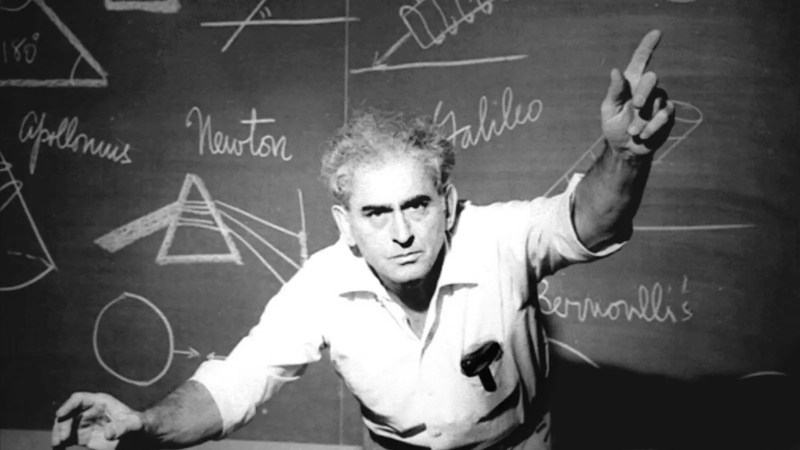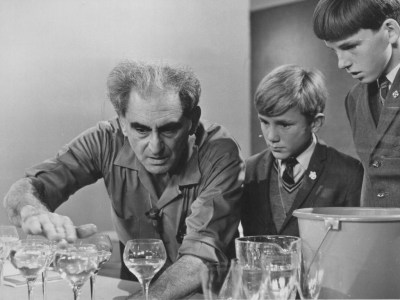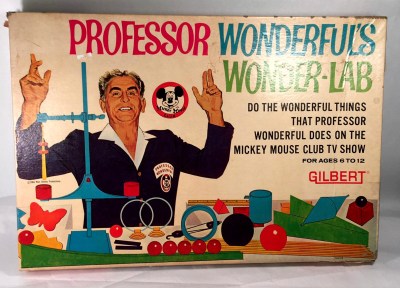
Let’s face it — for the average person, math and formulas are not the most attractive side of physics. The fun is in the hands-on learning, the lab work, the live action demonstrations of Mother Nature’s power and prowess. And while it’s true that the student must be willing to learn, having a good teacher helps immensely.
Professor Julius Sumner Miller was energetic and enthusiastic about physics to the point of contagiousness. In pictures, his stern face commands respect. But in action, he becomes lovable. His demonstrations are dramatic, delightful, and about as far away from boring old math as possible. Imagine if Cosmo Kramer were a physics professor, or if that doesn’t give you an idea, just picture Doc Brown from Back to the Future (1985) with a thick New England accent and slightly darker eyebrows. Professor Miller’s was a shouting, leaping, arm-waving, whole-bodied approach to physics demonstrations. He was completely fascinated by physics, and deeply desired to understand it as best he could so that he could share the magic with people of all ages.
Professor Miller reached thousands of students in the course of his nearly 40-year teaching career, and inspired millions more throughout North America and Australia via television programs like The Mickey Mouse Club and Miller’s own show entitled Why Is It So? His love for science is indeed infectious, as you can see in this segment about the shock value of capacitors.
Scintillated by Science
Julius Sumner Miller was born May 17th, 1909 in Billerica, Massachusetts, and was the youngest of nine children. His father was Latvian, and his mother was “a Lithuanian peasant who spoke twelve languages”. When Julius wasn’t busy with homework or chores on the family farm, he was consuming knowledge voraciously and “read the town’s library dry by the age of sixteen”. Years later, he used his own money to expand the library’s collection.
After high school, Julius went to Boston University and graduated in 1933 with degrees in philosophy and theoretical physics. It was impossible to find work in physics during the Depression, so Julius and his wife Alice spent two years working as butler and maid for a wealthy doctor. Finally, after sending out over 700 letters, Julius found work at a private school in Connecticut. A few years later, he was hired by the physics department of Dillard University in New Orleans in 1937 and stayed there for several years. During World War II, Julius also served as a civilian physicist for the US Army Signal Corps.

A Teacher Like None Other
In 1950, Professor Miller won a grant that gave him the opportunity to study under Albert Einstein, with whom he became lifelong friends. Einstein was his idol, and he had a collection of memorabilia, including a copy of the man’s birth certificate.
Around this time, Julius did a brief teaching stint at UCLA, but decided he wanted to be in a smaller setting. He went to teach at a junior college called El Camino in Torrance, California and stayed there until his retirement in 1974. Professor Miller was extremely popular with students throughout the years, though he was not all fun and games. He expected students to listen and work hard, and he didn’t tolerate misspelled words or misplaced punctuation.
He was also tough on his colleagues, believing that most educators weren’t rigid enough, and that students weren’t learning anything as a result. As early as the 1940s, the professor was quite vocal about the decline of education in the United States and pulled no punches when speaking about the situation. Although he enjoyed teaching anyone who would listen, Professor Miller’s favorite audience was children because “their spirit and curiosity has not yet been dulled by schools.”

Professor Wonderful, Why Is It So?
During the 1950s, Miller made 40 appearances as Professor Wonderful on the Mickey Mouse Club giving lively demonstrations each week. The professor proved popular and launched his own TV show in 1959 called Why Is It So? from Los Angeles. After a few years, he moved to Australia and stayed there for over twenty years. Professor Miller became a beloved celebrity in Australia and visited many times over the years. He also made the U.S. late-night talk show circuit and appeared on several television shows as himself.
Toward the end of his life, he made an unforgettable Cadbury commercial including a physics demonstration of pushing a hard-boiled egg into a glass bottle unscathed. In between demonstrations, he found the time to write several books including an autobiography that’s difficult to source, and contributed over 300 papers to scientific journals. A few of the books were full of “Millergrams” — physics-based brainteasers such as this gem:
Q32: A juggler comes to a footbridge of rather flimsy design. He has in hand four balls. The maximum load is no more than the juggler himself and one ball. Can he get across the bridge by juggling the balls, always having at most one ball in the hand (and three in the air)?
A: No. A falling ball exerts a force on the hand greater than its own weight. Rather, a “thrown” ball exerts greater force than a “held” one. That is, the additional force equal and opposite to that imparted to a flung ball, in addition to the juggler’s mass, would exceed the bridge’s tolerance (the bridge can tolerate a juggler and held ball, but not the additional downward force associated with forcing a ball “up”).
In the spring of 1987, Professor Miller developed leukemia and died soon after at age 77, having requested no services. Instead, he willed his body to the USC School of Dentistry. The professor’s legacy lives on thanks to YouTube, where you can watch many delightful demonstrations.
[Main image source: The Age]
Thanks for the tip, [John Wayt].
0 Commentaires